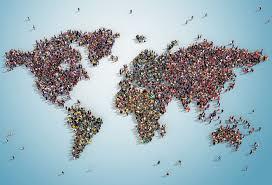As of 2022, the global population is growing at a rate of about 0.84% per year (down from 1.05% in 2020, 1.08% in 2019, 1.10% in 2018, and 1.12% in 2017). The current rate of population growth is estimated to be 67 million people per year.
Approximately 8.03 billion people
The total number of humans currently living on the planet is referred to as the world population. The world's population is currently estimated to be around 8.03 billion people. The first billion was reached around 1800, and we reached 7 billion in just 200 years.
The top 10 countries by population are:

1. China – 1.4 billion
2. India – 1.3 billion
3. United States – 335 million
4. Indonesia – 280 million
5. Pakistan – 231 million
6. Nigeria – 219 million
7. Brazil – 216 million
8. Bangladesh – 168 million
9. Russia – 146 million
10. Mexico – 132 million
The world population is expected to continue to grow in the future. The United Nations predicts that the world population will reach 9.8 billion by 2050. This growth will be driven by a combination of factors, including increasing life expectancy and declining fertility rates.
There are a number of factors that have contributed to this rapid population growth.
One of the most important is the dramatic increase in life expectancy. In 1950, the global life expectancy was just 47 years. Today, it is 72 years. This increase in life expectancy is due to a number of factors, including advances in medical science and technology, improved sanitation and hygiene, and better nutrition.
Another factor that has contributed to the world's population growth is the decline in fertility rates. In 1950, the global fertility rate was 5.0 births per woman. Today, it is 2.4 births per woman. This decline in fertility rates is due to a number of factors, including increased access to contraception, improved education and economic opportunities for women, and increased gender equality.
The world's population growth has a number of implications for the planet.
One of the most important is the impact on the environment. The world's population consumes a large amount of resources and produces a large amount of waste. This has a negative impact on the environment, contributing to climate change, pollution, and the depletion of natural resources.
The world's population growth also has implications for social and economic development. A growing population requires more food, water, and other resources. This can lead to increased competition for resources, which can in turn lead to social and economic conflict.
The world's population growth also has implications for security. A growing population can put a strain on a country's infrastructure and resources, which can lead to social unrest and even conflict.
The world's population growth is a complex issue with a number of implications for the planet. It is important to understand the trends and drivers of population growth in order to develop policies and programs that can mitigate its negative impacts.